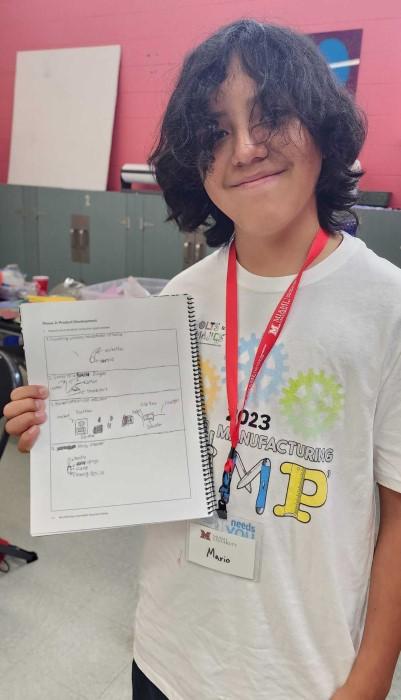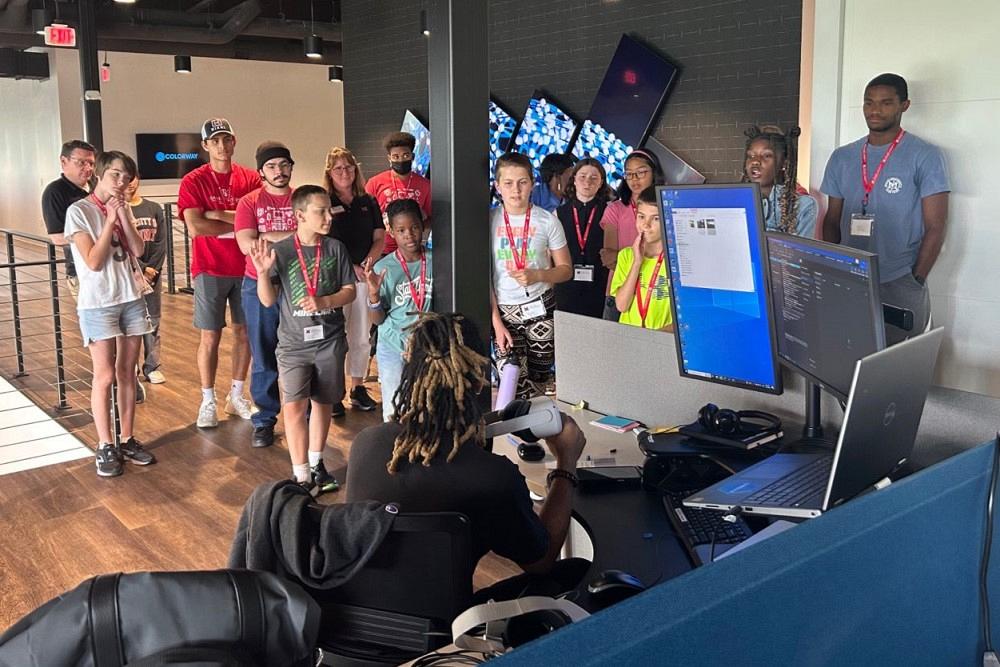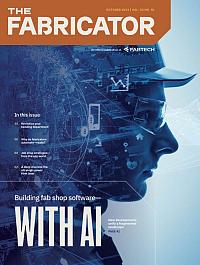Sr. Digital Editor
- FMA
- The Fabricator
- FABTECH
- Canadian Metalworking
Categories
- Additive Manufacturing
- Aluminum Welding
- Arc Welding
- Assembly and Joining
- Automation and Robotics
- Bending and Forming
- Consumables
- Cutting and Weld Prep
- Electric Vehicles
- En Español
- Finishing
- Hydroforming
- Laser Cutting
- Laser Welding
- Machining
- Manufacturing Software
- Materials Handling
- Metals/Materials
- Oxyfuel Cutting
- Plasma Cutting
- Power Tools
- Punching and Other Holemaking
- Roll Forming
- Safety
- Sawing
- Shearing
- Shop Management
- Testing and Measuring
- Tube and Pipe Fabrication
- Tube and Pipe Production
- Waterjet Cutting
Industry Directory
Webcasts
Podcasts
FAB 40
Advertise
Subscribe
Account Login
Search
NumberUp Innovation STEM camp introduces kids to manufacturing
Cincinnati middle schoolers get overview of all things manufacturing and learn how STEM can lead to future career opportunities
- By Gareth Sleger
- October 3, 2023
- Article
- Shop Management

Miami University engineering students and the Cincinnati Recreation Commission ran the multiweek NumberUp workshop as part of the NBT summer camp series. Gareth Sleger
An introduction to manufacturing has to start somewhere. And for kids in Cincinnati, Joanna Hohn hopes her NumberUp Innovation STEM camp provides that primer.
“We never know who all we’re impacting,” said Hohn, assistant director of college of engineering and computing outreach programs K-12 at Miami University in Oxford, Ohio. “If it’s just the student in the camp; if it’s an older sibling who hears about it; if it's other family or friends.”
This past July, Hohn, with the help of some Miami University engineering students and the Cincinnati Recreation Commission, ran the multiweek NumberUp workshop as part of the Nuts, Bolts & Thingamajigs (NBT) summer camp series. NBT is the foundation of the Fabricators and Manufacturers Association.
The camp offered the middle school-aged attendees an overview of all things manufacturing and how STEM not only plays a major role in the industry, but also can lead to future career opportunities.
"Most kids like working with their hands. So, this is just opening their eyes,” said Hohn, who’s in her second year running the NumberUp camp. “I think most of them don't have any idea what these types of jobs are. They're not seeing or hearing about it in school. Their teachers aren't in those fields. This just gives them that exposure and the chance to explore.”
In a classroom at the Corryville Recreation Center in urban Cincinnati, NumberUp campers were introduced to a wide variety of STEM-related technologies and processes, from prototyping to research and development to designing with software to running small-scale machines.
They learned Autodesk Tinkercad to design objects to 3D print and used Cricut cutting machines to cut different materials at certain depths.
And while students were mostly working with safe materials like cardboard, construction paper, and cardstock, Hohn believes that could translate to them problem-solving with sheet metal down the road.
“I think it’s important that we expose them to different types of engineering and allow them to problem-solve, which is a huge piece and something we talk about all the time,” Hohn said.
Ultimately, the main approach for the in-class exercises is that problems exist to be solved.
“There are no grades associated with this,” Hohn added. “If you try something and you fail, that's OK. You just talk about it, and you learn.”
But before the campers even started product design exercises, they visited a few Cincinnati-area manufacturing facilities, including Procter & Gamble Co., Energizer/Armor All, medical equipment maker Ethicon, and research and product development firm Kinetic Vision.
“We’re showing them STEM companies in their community where there are jobs,” said Hohn.
The students also got an up-close and personal view of manufacturing technologies in action. At the Procter & Gamble facility, they got a crash course on how the company uses automation, robotics, and additive manufacturing in all aspects of their engineering and logistical processes.
Hohn feels the facility tours were key to reinforcing what they were learning about prototyping in the classroom.
“How can we create a product if they haven’t even seen what that’s like? It helps that they've been to these places, and they’ve seen all of what goes on,” said Hohn. “What we’re doing here wouldn’t be the same without those STEM field trips. They can see how products evolve and change over time.”
Next year, Hohn hopes that she can use grant money to purchase some injection molding equipment for NumberUp campers to use on the Miami University campus.
“We've seen injection molding on our different field trips,” Hohn said. “Now we want them to be able to use it themselves.”
She also hopes to continue to expand efforts to reach all demographics in Cincinnati’s diverse urban population. And, with that, continue to hire camp staff from Miami University that reflect that diversity.
“We need to diversify the pipeline coming into all of these jobs,” Hohn said of the all the manufacturing sectors. “We have a very diverse group of students here at all of our urban sites. It's important to connect with them. That's been really beneficial.”
About the Author

Related Companies
subscribe now

The Fabricator is North America's leading magazine for the metal forming and fabricating industry. The magazine delivers the news, technical articles, and case histories that enable fabricators to do their jobs more efficiently. The Fabricator has served the industry since 1970.
start your free subscription- Stay connected from anywhere

Easily access valuable industry resources now with full access to the digital edition of The Fabricator.

Easily access valuable industry resources now with full access to the digital edition of The Welder.

Easily access valuable industry resources now with full access to the digital edition of The Tube and Pipe Journal.
- Podcasting
- Podcast:
- The Fabricator Podcast
- Published:
- 04/16/2024
- Running Time:
- 63:29
In this episode of The Fabricator Podcast, Caleb Chamberlain, co-founder and CEO of OSH Cut, discusses his company’s...
- Trending Articles
Tips for creating sheet metal tubes with perforations

Are two heads better than one in fiber laser cutting?

Supporting the metal fabricating industry through FMA

JM Steel triples capacity for solar energy projects at Pennsylvania facility

Omco Solar opens second Alabama manufacturing facility

- Industry Events
16th Annual Safety Conference
- April 30 - May 1, 2024
- Elgin,
Pipe and Tube Conference
- May 21 - 22, 2024
- Omaha, NE
World-Class Roll Forming Workshop
- June 5 - 6, 2024
- Louisville, KY
Advanced Laser Application Workshop
- June 25 - 27, 2024
- Novi, MI




























